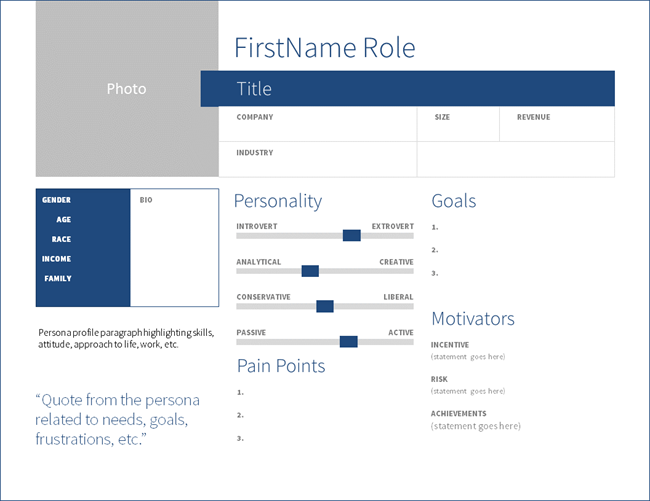By Cathy Dew
In case you missed it, here are the first four blogs in our series on business process analysis templates:
This week we look at personas...
Personas are detailed profiles of fictional characters that represent a specific segment of users within a targeted demographic. Analysts and designers can create personas that reflect a fully realized example of who is the target audience for a website, intranet or application. Personas help application designers fully envision and understand the different attitudes and behaviors of users within various demographic segments.
The goal is for the persona to capture the specific information that is relevant and necessary to reflect the demographic they represent. Depending on your project, some aspects of a persona will be more or less important and some cases, not important at all. Here is a that can be used to build a foundation for your personas:
- Persona Name: The idea is for the personas to become part of the project team. Best practices say to give them a standard first name and then use their role or title as the last name, for example, Sandra Sales Manager. Pretty quickly the team will know who Sandra is.
- Attributes: Differentiating characteristics which reflect the particular demographic that the persona represents include age, gender, ethnicity, marital status. Depending on the project it may also be important to know their employer, title and salary.
- Persona Image: A representative picture is typically used to create a sense of realism and to give designers a firm anchoring point for the persona within their mind.
- Goals: What the persona is trying to achieve, relative to your project. (Identify 3-5)
- Skills: Specific abilities the persona embodies as it relates to your focus are. Some personas may cross over or combine job tasks and duties.
- Behaviors/Desires: The types of behaviors has and statement of what motivates the persona to act a specific way can add to the value of the persona. It is important to understand frustrations and pain points. (Identify 3-5)
- Character: Details about the persona’s character add a sense of realism and lead to a better representation of an actual user. This may be motivators like incentives, risk and achievements. Or it could be personality traits like where the persona fits on a scale of introvert/extrovert, passive/active or analytic/creative.
- Location/Environment: The surrounding environment that the persona functions within, the environmental factors can have such a large influence on behavior.
As you can see there is a lot to choose from when describing a persona. Spend time to consider what is important in the context of your project to help narrow down this list. Personas are not usually more than a page or two in length. They are useful in business analysis process efforts to help you focus on exactly who you are designing for, which almost always is not you. For reference please click here to download a sample persona template.

Your personas can help guide product or application design decisions regarding features and user interactions. They can be printed and hung on the wall for all analysts and designers to see and be reminded of, as they complete their day-to-day activities. In this way, the personas become socialized into the surrounding environment.
You might think that it doesn’t make a difference. But consider “putting on the hat of the customer”, it makes a great deal of difference in how you:
- Envision
- Prioritize
- Design
- Build
- Test
- Deploy
Here is an example of the persona development methodology taken from a case study for a client's intranet development project.
- First, we surveyed employees to classify the different types of end user of the Intranet. The survey focused on goals, behaviors, attitudes and usage of the intranet.
- We followed this up with detailed one-on-one interviews that covered a wide range of employees and divisions. Then we summarized the findings in the form of task scenarios and personas.
- Finally, we checked the legitimacy of the personas by distributing them to stakeholders within the organization. Then we revised and finalized the personas according to their comments.
One of the other long lasting benefits of developing personas is the collaboration and refinement in understanding that occurs across the project team and who the target customer is and how we can support their goals. Having personas allows the team to more easily separate personal opinions and prejudices and really focus on what would Sally Sale Manager would do.
By doing this work early in the development of a project, you can avoid a significant number of design flaws, reducing the necessary development and re-development efforts and costs considerably.
In the end, it really is all about the end user or customer. Let personas be active participating members of your project team to keep your project on track and user-centered. If you need help navigating this process, feel free to reach out to 2Plus2! We are always happy to help create personas that drive user-centered design. Call us at (510) 652-7700.